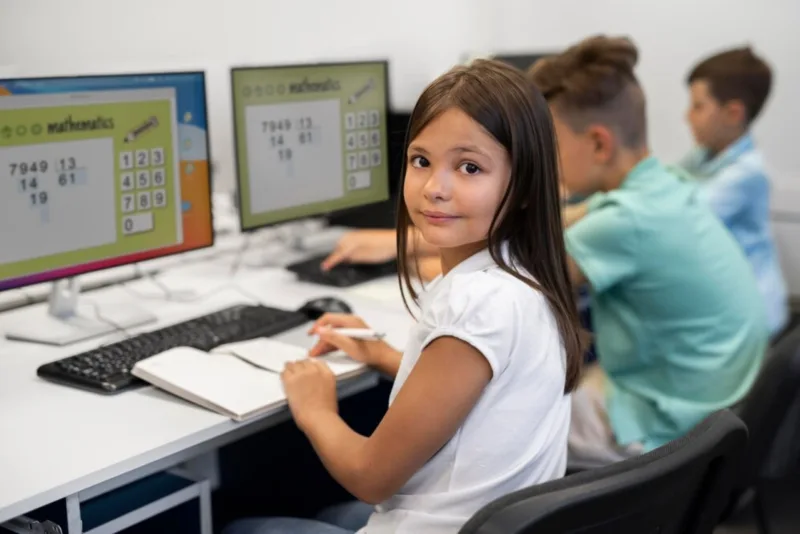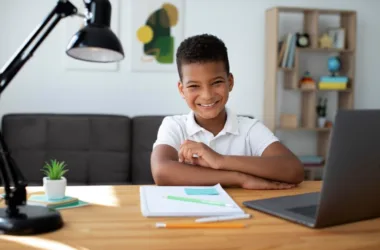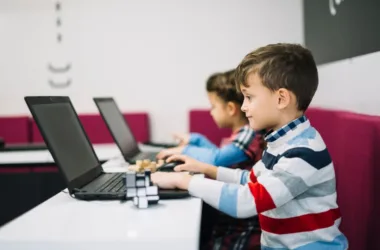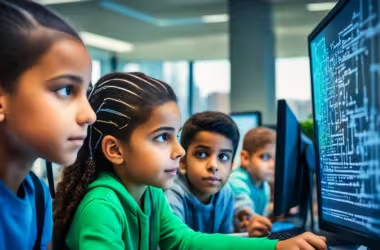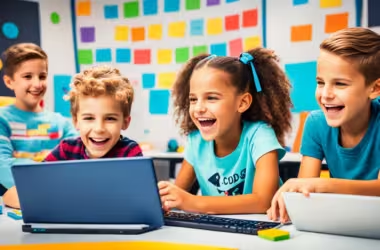Are you a parent or educator wondering how to introduce your child to coding? Are you also feeling overwhelmed by the multitude of resources and options available? You’re not alone.
A recent study found that over 50% of jobs in the United States now require some level of coding ability.
This only highlights the growing importance of equipping children with the skills they need to thrive in the 21st-century workforce.
In this blog post, we’ll address common questions and concerns parents and educators have about teaching coding to kids.
We’ll look at the benefits of coding for kids, why it’s considered one of the top skills for kids to learn, and resources to help your kids get started.
But first, what’s coding?
What is Coding?
Coding is simply a way to communicate with electronic devices by converting human input into numerical sequences that computers can understand.
In other words, we use specific instructions written in a computer-understandable coding language in place of words and sentences. The computer is instructed on what to do, step-by-step, by these instructions.
The resulting set of instructions is referred to as the program’s “source code.” Eventually, the word gained importance and was referred to as “code.” Thus, “coding” refers to the process of working on the source code when developing software, an app, or a website.
There are numerous coding languages, each with its own set of symbols and conventions, such as HTML, C++, Python, JavaScript, and others.
Learning to code requires practice, much like acquiring a new language. But there are kid-friendly programs that make learning to code enjoyable and simple.
These programs often use pictures or drag-and-drop features instead of complicated words, so kids can focus on the exciting parts – creating something cool with their computer!
In a nutshell, computers can only understand machine language. The process of creating these instructions is called coding, and code is the set of instructions that are given to a computer.
Why Should Kids Learn to Code?
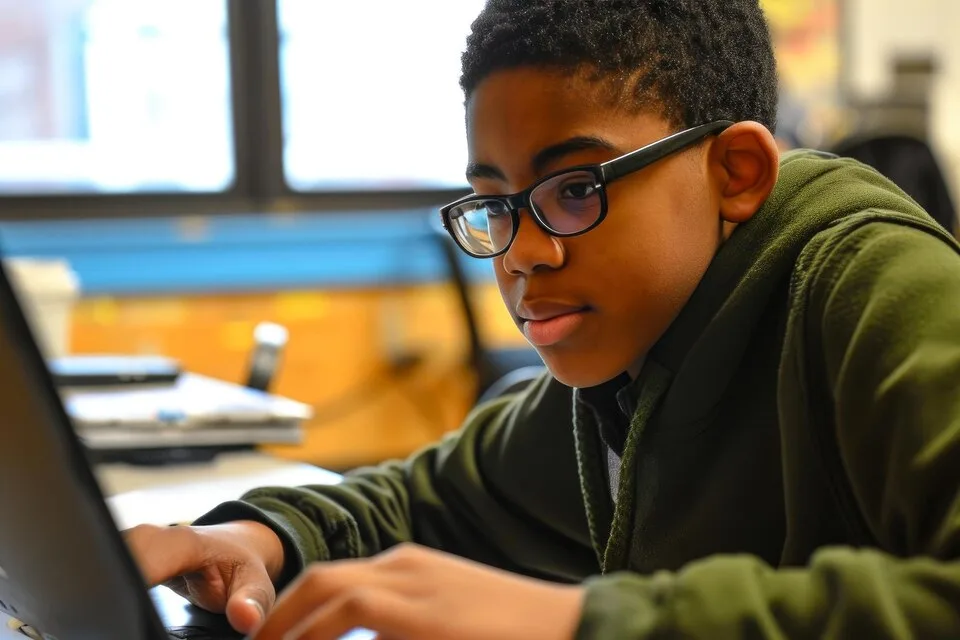
Imagine being able to control your computer like a superhero with a secret weapon. That’s what coding can do for kids! Here’s why learning to code is such a cool superpower;
- Build Awesome Things: When kids code, it allows them to create their own video games, animations, or even websites. This only means the sky is their limit with coding.
- Problem-Solving Champions: Coding teaches kids how to break down problems into small steps, just like figuring out how to build a LEGO castle. This makes them super problem-solvers in all areas of life!
- Boosting the Brain: Just like learning a new language, coding gives your brain a workout. It improves memory, and critical thinking, and even helps with math skills.
- Future Ready: The world is full of technology, and knowing how to code is sure a great thing considering how valuable it is nowadays. It opens doors to exciting careers and helps kids understand the world around them.
- The Fun Factor: Coding can be like playing a game or building a puzzle. Many cool programs with colorful pictures and drag-and-drop features make learning fun and engaging for kids.
For a more comprehensive guide on this read our in-depth guide on why Kids should learn coding.
What Age Can Kids Start Coding?
A child as young as five years old can start learning to code. Experts in child development say that the best time to learn a new language and become fluent is between the ages of 2 and 7.
Learning to code is similar to learning a new language fluently since it requires your brain to combine new syntax and vocabulary into creative expression.
Naturally, there will be difficulties in the way children learn to code. Children are not as resilient as adults, and they learn in various ways.
The failures are necessary milestones since every level of coding involves some degree of failure. It entails figuring out how to make a piece of code better as well as why and how it fails.
Children learn that failure is a necessary part of the coding process by facing these difficulties from the start.
How Is Coding Taught To Children?
Basic coding classes don’t even require the use of a computer, even though the concept of teaching code may appear intimidating and difficult. Lessons in coding can go from basic to advanced.
A computer-free lecture is called “unplugged” since it removes the need for computer technology. One possible use of unplugged introductory classes is to teach students the terminology of coding.
For instance, one of the core ideas of coding is writing an algorithm. A set of steps used for completing a task is called an algorithm. Students can understand this concept by writing algorithms of their school routine using the “unplugged” attitude.
One way of introducing the kids to writing is having them create an algorithm out of the procedures they take to get dressed every morning. at first, secondly, and thirdly, what do they do?
There is no need to use any “code” to begin; they can write this method as if they were speaking with a human.
Basic Coding Concepts and to Get Kids Interested in It
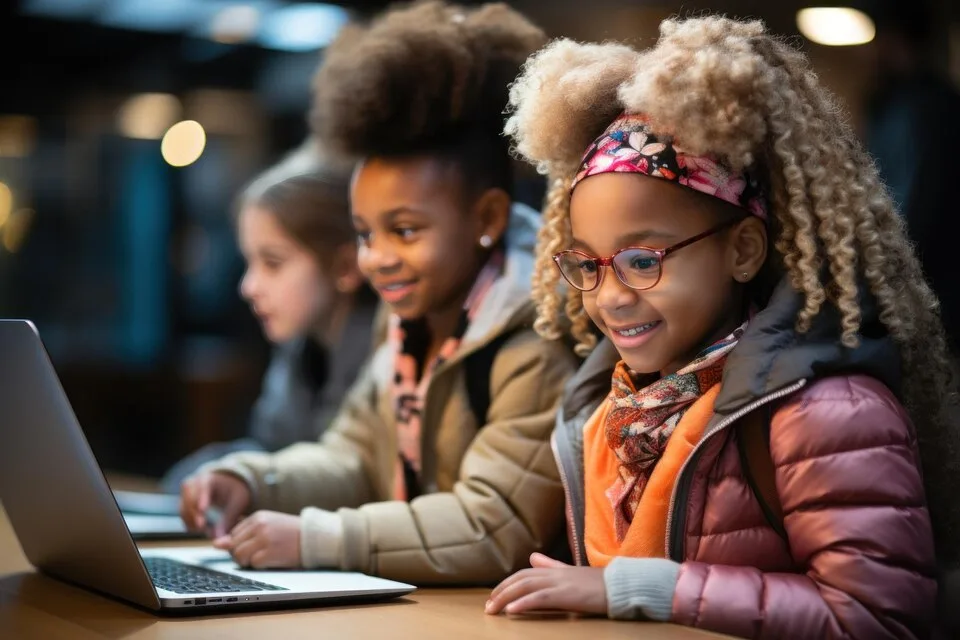
Teaching coding to kids doesn’t have to be boring! In fact, It can be really fun and exciting. Here are some basic coding concepts that can get kids interested;
Understanding Instructions and Sequences
- Start by teaching kids about giving instructions in a particular order, just like telling a story step by step. This helps them understand the idea that computers follow instructions in sequence.
Using Loops and Conditionals
Introduce loops, which are like repeating patterns in code. For example, looping through a set of instructions to draw a shape multiple times.
Also, show them conditionals, which are like decision-making in code. For instance, if something happens, then do this; otherwise, do that.
Building Blocks of Code (like Variables and Functions)
Kids can learn about variables, which are like containers for storing information, such as numbers or words. And functions, which are like shortcuts for repeating sets of instructions.
For example, instead of writing the same code over and over, they can use a function to do it more efficiently.
Basic Programming Languages That Are Kid-Friendly
Learning to code is like learning a new language, and just like with languages, some are easier for kids to pick up than others. Here are a few programming languages that are designed with kids in mind;
- Scratch: Scratch is a block-based visual programming language developed by MIT. It uses colorful blocks that snap together to create code, making it easy for kids to understand and use. With Scratch, kids can create animations, games, and stories by dragging and dropping blocks.
- Blockly: Blockly is another block-based programming language that’s similar to Scratch. It’s used in platforms like Code.org and Google’s Blockly Games. Blockly is great for teaching kids the basics of coding through interactive puzzles and games.
- Lua: Lua is a lightweight scripting language that’s easy to learn and commonly used in game development. It’s known for its simplicity and flexibility, making it a great choice for kids who want to dive into game programming.
- Java: Java is a widely used programming language in the tech industry, and while it’s more complex than some of the other languages on this list, there are beginner-friendly resources available for kids who want to learn Java. It’s a good language to learn for building Android apps and Minecraft mods.
- HTML and CSS: HTML and CSS are the building blocks of web development. HTML is used to create the structure of web pages, while CSS is used to style them and make them look good. Kids can learn the basics of HTML and CSS by creating their web pages and styling them however they like.
Coding Resources for Kids
So you might ask, where can I find some good coding resources for kids, here you have it. Below are different kinds of coding resources for kids;
- Free Online Coding Platforms
Websites like Scratch and Code.org offer free, interactive coding tutorials and activities for kids of all ages. These platforms use engaging games and projects to teach coding concepts in a fun and accessible way.
Here are some recommendations;
- Scratch: Developed by MIT, Scratch is a popular platform where kids can create interactive stories, games, and animations using block-based coding.
- Code.org: Offers free coding tutorials and activities for kids, featuring courses like “Hour of Code” and “CS Discoveries”.
- Paid Online Coding Platforms
Let’s look at some paid coding platforms;
- Tynker: Provides coding courses for kids with interactive lessons, coding challenges, and projects covering various programming concepts and languages.
- Codecademy: Offers paid courses on coding languages like Python, JavaScript, and HTML/CSS, with interactive coding exercises and projects
- Coding Apps for Kids (for tablets and phones):
Here are some apps with interactive lessons, games, and challenges that make learning coding fun and engaging.;
- Kodable: An app designed to teach programming concepts to kids as young as 4 through games and activities.
- Lightbot: A puzzle game app that introduces programming logic by solving challenges using programming concepts like loops and conditionals.
- Coding Classes and Bootcamps
Here are some coding classes and boot camps with more structured learning experiences;
- CodeWizardsHQ): Offers online coding classes for kids ages 8-18, covering topics like web development, game design, and Python programming.
- ID Tech: Provides in-person and online coding camps for kids and teens, offering courses in game development, robotics, and more.
- Books and Other Learning Materials
- Hello Ruby series by Linda Liukas
- Coding Projects in Scratch by Jon Woodcock
Fun Coding Projects for Kids
Coding doesn’t have to be all about learning syntax and algorithms – it can also be incredibly fun and creative! Here are some coding projects that kids can enjoy:
- Create Your Own Game: Encourage kids to design and build their own video games using platforms like Scratch or GameMaker Studio. They can let their imagination run wild, designing characters, levels, and gameplay mechanics.
- Animate a Story: Have kids write a short story or script, then bring it to life by creating animations using coding tools like Scratch or Pencil2D. They can experiment with different animation techniques and add sound effects and music to enhance their creations.
- Build a Website: Introduce kids to web development by teaching them how to build their own websites using HTML, CSS, and JavaScript. They can create personal blogs, portfolios, or even online galleries to showcase their artwork.
- Design a Chatbot: Challenge kids to create their own chatbot using platforms like Chatfuel or Dialogflow. They can program the chatbot to respond to user inputs and carry on conversations on a variety of topics.
These projects not only help kids learn coding concepts in a hands-on way but also allow them to express their creativity and develop problem-solving skills.
How to make coding fun and engaging for kids?
Making coding fun and engaging for kids is all about tapping into their interests. The beauty of it is that it allows them to turn their ideas into reality.
Here are some quick tips to make it fun and engaging for them;
- Gamify Learning: Turn coding into a game by setting goals, earning rewards, and incorporating elements like levels, challenges, and badges. Platforms like CodeCombat and CodeCombat provide a gamified approach to learning coding concepts.
- Project-Based Learning: Encourage kids to work on real-world projects that are relevant to their interests and passions. Whether it’s designing a website for their favorite hobby or creating a video game based on their favorite story, project-based learning makes coding more meaningful and engaging.
- Collaborative Learning: Foster a sense of community and collaboration by encouraging kids to work together on coding projects. They can brainstorm ideas, solve problems, and learn from each other’s experiences, creating a supportive and motivating environment for learning.
Frequently Asked Questions
In this section, we’ll be looking at some of the frequently asked questions regarding coding for kids;
Do you need coding courses to get your kids started?
No, coding courses aren’t necessary to get kids started with coding. Free resources like tutorials and coding platforms offer great starting points. Parents can introduce coding through fun activities. Paid courses provide structured learning and expert guidance if your child prefers a more formal approach or wants advanced topics.
What are the benefits of paid coding courses?
Paid courses offer structured learning with clear objectives and expert instruction. Kids receive personalized feedback and access to advanced content. Completion may lead to certification or badges, showcasing their skills.
Paid courses are beneficial for structured learning, but free resources also offer valuable learning opportunities.
Is there a difference between coding and programming?
Yes, while the terms are often used interchangeably, there’s a subtle difference. Coding is writing instructions in a programming language to create software, websites, and more. Programming encompasses a wider range of activities, including problem-solving, testing, debugging, and software design.
Why is coding for kids one of the top skills to learn?
Coding teaches valuable skills like problem-solving, creativity, and critical thinking. In our digital world, coding opens up future job opportunities across various industries. It empowers kids to become creators and prepares them for success in a technology-driven society.
Final Thoughts
Teaching kids to code helps them learn important skills like problem-solving and creativity, which will help them in the future.
Whether they use free online tools or take classes, it’s important to make coding fun.
Encourage them to try new things and not be afraid of challenges. Coding isn’t just about writing lines of code; it’s about endless possibilities.
Let’s inspire kids to be the creators of tomorrow. Together, we can help them succeed in a world full of technology


